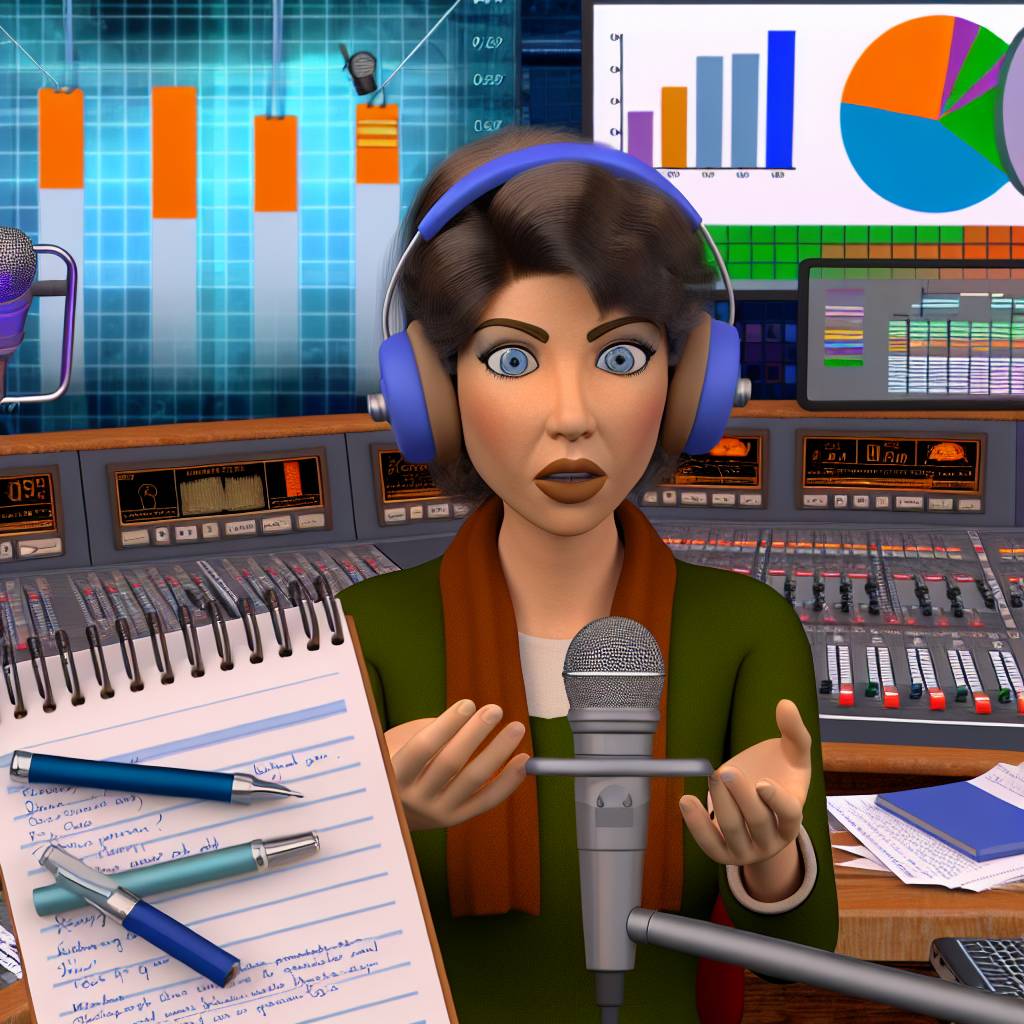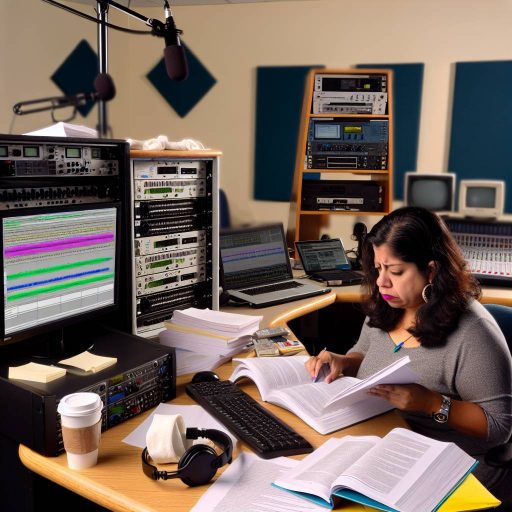Introduction
Radio shows come in various formats.
Each serves distinct audience interests.
Understanding these formats is crucial for engaging listeners effectively.
Successful radio broadcasting relies on selecting the right format and tailoring content accordingly.
Overview of Radio Show Formats
Several popular radio show formats exist today.
Talk radio focuses on conversations.
It often features interviews and listener call-ins.
Music radio primarily delivers songs.
This enhances entertainment and discovery.
News programs provide current events analysis.
They present both national and local stories.
Additionally, sports talk shows focus on sporting events.
They offer commentary and expert insights.
Educational programs emphasize learning.
These cover diverse topics in-depth.
Importance of Understanding Formats
Choosing the appropriate radio show format influences listener retention.
An intriguing format attracts and keeps an audience.
This boosts show ratings significantly.
Understanding each format allows for innovation and creativity in content delivery.
Different demographics respond to unique formats.
Transform Your Career Today
Unlock a personalized career strategy that drives real results. Get tailored advice and a roadmap designed just for you.
Start NowYounger audiences might favor energetic music shows.
Meanwhile, older listeners may prefer talk or news formats.
Radio broadcasters must analyze their target demographics.
This helps in selecting the ideal format for engagement.
Customizing Content for Success
Once a format is chosen, programmers must customize content.
It should fit that specific style.
A talk show may feature interviews with relevant guests.
Listener calls may be interspersed throughout.
Meanwhile, a music show might focus on curated playlists.
These playlists should resonate with current trends.
Consistency in format helps create a loyal listener base.
Regularly delivering content aligns with listener expectations.
This strengthens audience connections over time.
This understanding leads to increased listener satisfaction.
It also contributes to program longevity.
Driving Engagement and Loyalty
Grasping radio show formats is essential for effective broadcasting.
Knowledge of these formats provides a roadmap for success.
It drives listener engagement and loyalty over time.
Types of Radio Show Formats
Radio shows can take many forms.
Each format serves a unique purpose.
Transform Your Career Today
Unlock a personalized career strategy that drives real results. Get tailored advice and a roadmap designed just for you.
Start NowSome focus on music, while others emphasize talk and discussion.
Understanding these formats helps listeners choose shows that fit their preferences.
Music-Based Radio Shows
Music-based radio shows showcase various genres and artists.
They attract diverse audiences through their playlists.
These shows often encourage listener interaction.
Here are the main characteristics of music-based shows:
- Genre-Focused: Many shows specialize in a specific music genre.
- Artist Spotlights: Some formats feature interviews with artists.
- Live Performances: Certain shows host live music segments.
- Listener Requests: Many music shows invite listener participation.
- Thematic Playlists: Shows often create playlists around specific themes.
Music-based radio shows often experiment with formats.
They integrate different elements to maintain listener interest.
For example, a show might blend music with interviews or discussions about new releases.
This variety enriches the listener’s experience.
Talk Radio Format
Talk radio covers a vast array of subjects.
These shows usually feature lively discussions and debates.
They engage listeners on important topics ranging from politics to relationships.
Here’s an overview of the talk radio format:
- Interview Segments: Talk shows frequently host experts, authors, or celebrities.
- Listener Call-Ins: Audience participation is key.
- Topical Segments: Many shows feature segments focusing on current events or specific issues.
- Panel Discussions: Some talk shows feature multiple guests.
- Humor and Commentary: Many hosts incorporate humor.
The beauty of talk radio lies in its spontaneity.
Hosts often respond to current events as they unfold.
This dynamic nature keeps the format fresh and engaging.
Listeners appreciate the authenticity of unscripted conversations.
News and Sports Format Overview
News and sports formats provide timely information.
They keep listeners updated on current events and sports developments.
Transform Your Career Today
Unlock a personalized career strategy that drives real results. Get tailored advice and a roadmap designed just for you.
Start NowThese shows follow a structured approach to deliver important news quickly.
Some key elements include:
- Breaking News: Many news shows prioritize breaking news stories.
- Regular Segments: Most shows have designated segments for specific news categories.
- Analysis and Commentary: Many programs feature analysts or experts.
- Sports Updates: Sports formats provide updates on games, scores, and player statistics.
- Interviews with Athletes and Coaches: Many sports shows feature interviews.
News and sports formats emphasize accuracy and timeliness.
Reporters often cover events live or shortly after they occur.
This immediacy fosters trust and credibility with the audience.
Listeners rely on these shows to stay informed.
Each radio show format serves unique purposes.
Music-based shows evoke emotions through sound.
Talk radio stimulates engagement through conversation.
News and sports formats inform the public about essential events.
Choosing a format often depends on personal preferences and interests.
Consider what resonates most with you.
Whether it’s compelling discussions, exciting music, or breaking news, there’s a perfect radio show for everyone.
As the radio landscape evolves, these formats continue adapting.
New technologies and platforms change how audiences access content.
Streaming services and podcasts play a significant role now.
Still, traditional radio remains essential.
Its ability to connect communities and provide a shared experience continues to thrive.
As listeners, we can explore and enjoy the diversity of radio formats today.
The Role of Programming in Radio Shows
Programming serves as the backbone of radio shows.
Transform Your Career Today
Unlock a personalized career strategy that drives real results. Get tailored advice and a roadmap designed just for you.
Start NowIt shapes content and engages audiences.
A well-crafted program acts as a roadmap, guiding hosts and producers throughout the broadcast.
Understanding the elements of effective programming is essential for radio success.
Importance of Creating Engaging and Relevant Content
Engaging content plays a crucial role in keeping listeners tuned in.
The right content resonates with the audience, fostering loyalty and trust.
Here are key factors that define engaging content in radio programming:
- Relevance: Content must align with audience interests and current events.
- Diversity: Offer a mix of topics, genres, and formats.
- Creativity: Innovative ideas and unique perspectives make content memorable.
- Interactivity: Encourage listener participation through calls, social media, or polls.
- Quality: Ensure high production values, clear audio, and well-researched information.
Creating engaging content requires continuous effort and focus.
Producers must stay updated on trends, listen to audience feedback, and analyze what works well.
This proactive approach helps refine programming to enhance listener experience.
Planning and Scheduling of Programs
Effective planning and scheduling are essential to successful radio shows.
A well-structured schedule maximizes audience reach and engagement.
Here’s how to approach planning and scheduling:
- Define Goals: Identify the primary objectives of each program.
- Create a Content Calendar: Develop a schedule outlining topics, hosts, and guest appearances.
- Segment Programs: Break down shows into segments or features.
- Optimize Timing: Determine the best times to air specific programs.
- Review and Adjust: Regularly assess programming effectiveness and audience response.
Effective scheduling creates a predictable rhythm for listeners.
Knowing when to tune in for specific content fosters habit among the audience.
Predictability enhances listener loyalty and engagement.
Audience Research and Targeting
Understanding the audience remains a cornerstone of effective radio programming.
Audience research helps define who listens, why they tune in, and what they want.
Targeted programming leads to higher engagement and satisfaction.
Here’s how to approach audience research:
- Conduct Surveys: Use listener surveys to gather information about preferences and interests.
- Analyze Demographics: Study listener demographics, such as age, gender, and location.
- Monitor Listening Habits: Utilize analytics tools to track listener behavior, peak listening times, and popular segments.
- Engage on Social Media: Utilize social platforms to interact with listeners.
- Test Content: Pilot new segments or shows to gauge audience reactions.
Understanding audience preferences enhances programming relevancy.
Transform Your Career Today
Unlock a personalized career strategy that drives real results. Get tailored advice and a roadmap designed just for you.
Start NowWhen audiences feel heard, they engage more actively with content.
This engagement often translates into higher listener retention and increased loyalty.
Creating Dynamic Listener Experiences
Programming in radio shows plays an essential role in the overall success of the broadcast.
Through engaging and relevant content, thorough planning and scheduling, and targeted audience research, radio producers can create dynamic listening experiences.
A well-programmed show resonates with listeners, builds loyalty, and grows the station’s influence.
By continually adapting to listener needs and preferences, radio stations can thrive in an ever-evolving media landscape.
Gain More Insights: Top Podcasts for Aspiring Audio Engineers
Understanding your audience is crucial for crafting a successful radio show.
Listeners come from varied backgrounds, with distinct interests and preferences.
By grasping who your audience is, you can tailor your content to fit their needs, enhancing engagement and satisfaction.
Demographics and Psychographics of Radio Show Listeners
Demographics and psychographics offer insight into who is tuning in to your station.
Knowing these factors helps you design relevant programming that resonates with your audience.
Here’s what each entails:
- Demographics: This includes age, gender, income level, education, and location. Understanding demographics outlines the basic characteristics of your listeners.
- Psychographics: This aspect focuses on personality, values, interests, and lifestyles. Knowing psychographics digs deeper into your audience’s motivations and preferences.
A few essential demographic factors to consider include:
- Age: Different age groups favor different content. Younger audiences might enjoy music and pop culture, while older listeners might prefer talk shows that discuss current events.
- Gender: Programs can vary based on gender preferences. Research shows that men and women often have different interests regarding entertainment and information.
- Income Level: Understanding the income bracket helps determine advertising strategies. Higher-income listeners may prefer premium services, while lower-income audiences may favor bargain-related content.
- Education: Tailoring content based on educational background can enhance relevance. More educated audiences might appreciate in-depth discussions and analysis.
- Location: Local content can drive listener loyalty. Geography influences regional interests, dialects, and even the news that matters to your audience.
Incorporating psychographics provides a more nuanced view of your audience.
Key psychographic factors include:
- Values: Knowing what values resonate with your audience allows better storytelling. Values might include family, community, health, or sustainability.
- Lifestyle: Your listeners’ lifestyles can dictate their listening habits. Busy professionals might prefer concise content, while stay-at-home parents might enjoy longer shows.
- Hobbies and Interests: Understanding listeners’ hobbies allows for tailored content. If a significant portion enjoys sports, incorporating that theme can draw more interest.
- Media Consumption Habits: Knowing where your audience spends their time can shape promotional efforts. Some might prefer mobile apps, while others stick to traditional radio broadcasting.
Tailoring Content to Target Audience Preferences
Once you identify your audience demographics and psychographics, you can tailor your content accordingly.
Customizing your shows boosts listener engagement and satisfaction.
Here are practical methods for achieving this:
- Content Variety: Mixing formats, such as interviews, news, and music, caters to diverse listener preferences. This approach keeps content fresh and engaging for a broader audience.
- Thematic Programming: Creating themed shows can attract niche audiences. For example, a show focused on local history can engage listeners with specific interests.
- Seasonal Content: Aligning content with seasonal events or holidays helps maintain relevance. Shows about festivities, summer activities, or year-end reviews can enhance listener connection.
- Interactive Segments: Encouraging audience participation creates a sense of community. Invite listeners to call in, share stories, or participate in polls during live broadcasts.
- Featured Guests: Inviting guests who resonate with your audience can enhance credibility and attract their followers. Celebrities, experts, or local figures can add value to conversations.
Understanding your audience’s listening habits also helps in creating engaging content.
Transform Your Career Today
Unlock a personalized career strategy that drives real results. Get tailored advice and a roadmap designed just for you.
Start NowConsider the following:
- Peak Listening Times: Identify when your audience listens the most. Tailor your programming to include essential content during these peak hours.
- Preferred Show Duration: Different audiences may have different tolerances for show lengths. Know if your listeners prefer shorter, bite-sized segments or longer, in-depth discussions.
- Genre Preference: Knowing if your audience favors talk shows, music, or storytelling allows for genre-specific programming that enhances listener experience.
Utilizing Listener Feedback for Show Improvement
Listener feedback plays a vital role in refining your shows.
Actively seeking, analyzing, and implementing this feedback can drive content improvements.
Here are a few effective strategies:
- Surveys and Polls: Regularly conduct surveys to gather audience opinions on various aspects of your programming. This can include show topics, hosts, and guest appearances.
- Social Media Engagement: Utilize social media platforms to connect with your audience. Engaging with listeners online allows you to gather real-time feedback and respond promptly.
- Listener Call-ins: Encourage spontaneous feedback through listener calls. This immediate response can uncover issues or interests that surveys may miss.
- Focus Groups: Organizing focus groups offers deeper insights into audience perceptions. Engaging with a representative sample allows for a more nuanced understanding of audience preferences.
- Post-Show Discussions: Host discussions after show broadcasts to get feedback from dedicated listeners. This approach encourages loyalty and builds community.
Understanding your audience requires a holistic approach.
By analyzing demographics and psychographics, you can create tailored content.
Utilizing listener feedback ensures constant improvement and keeps your audience engaged.
Remember, a loyal listener base is built on connection and relevant content.
By prioritizing these strategies, you create shows that resonate deeply with your audience.
Understanding your listeners leads to compelling programming that keeps them coming back for more.
Gain More Insights: Drone Videography: A Guide for Beginners
Creative Production Techniques
Radio shows provide an opportunity to engage and entertain listeners through creative production techniques.
Show producers can enhance the listener experience using various elements.
These include sound effects, music transitions, live interviews, and storytelling methods.
Each component contributes to the overall production quality.
Below are some effective techniques for creating engaging radio shows.
Incorporating Sound Effects and Music Transitions
Sound effects and music transitions breathe life into radio shows.
They create an immersive experience for listeners, making the content more memorable.
Here are several key points to consider:
- Set the Tone: Use sound effects to establish the show’s mood. For instance, dramatic music can create suspense.
- Transition Smoothly: Use music clips to transition between segments. This helps maintain listener engagement during changes.
- Enhance Storytelling: Sound effects can complement narratives. For example, adding nature sounds during outdoor storytelling creates vivid imagery.
- Capture Attention: Unexpected sounds can grab a listener’s attention. A sudden sound effect can alert listeners to important moments.
- Consistent Branding: Select music that aligns with the show’s identity. Consistent use of particular tunes reinforces show branding.
By carefully incorporating sound effects and music, producers can elevate their content.
Transform Your Career Today
Unlock a personalized career strategy that drives real results. Get tailored advice and a roadmap designed just for you.
Start NowThis strategy captivates listeners and enhances their overall experience.
Using Interviews and Live Call-Ins to Enhance Shows
Incorporating interviews and live call-ins adds depth to radio shows.
These elements enrich content by providing diverse perspectives.
Here are some benefits of utilizing these techniques:
- Diverse Perspectives: Interviews introduce varying viewpoints. Different guests provide unique insights and stories.
- Interactive Engagement: Live call-ins encourage listener participation. They allow audiences to directly contribute to the conversation.
- Expert Opinions: Bringing experts onto the show adds credibility. Listeners often trust information presented by knowledgeable figures.
- Real-Time Reactions: Live interactions capture spontaneous reactions. These moments often create excitement and unpredictability.
- Personal Stories: Guests can share personal experiences. These stories create emotional connections with the audience.
Integrating interviews and call-ins creates a dynamic radio atmosphere.
This technique draws in listeners and fosters a sense of community.
Effective Storytelling Methods for Engaging Listeners
Storytelling forms the backbone of compelling radio shows.
Engaging narratives captivate audiences and create lasting impressions.
Here are some storytelling methods that enhance listener engagement:
- Hook the Audience: Start with an attention-grabbing opening. This could be a question, a shocking fact, or a powerful quote.
- Use Relatable Characters: Create characters your audience can connect with. Relatability fosters empathy and engagement.
- Build Suspense: Introduce challenges or conflicts. This keeps listeners on the edge of their seats and eager for resolutions.
- Layering Details: Weave in vivid descriptions and sensory details. Engaging the senses draws listeners deeper into the narrative.
- Incorporate Dialogue: Use dialogue to create realism. Conversations between characters make them feel authentic.
- Establish a Clear Structure: Organize stories with a clear beginning, middle, and end. A well-structured story keeps listeners engaged.
- Leave Them Wanting More: End with a cliffhanger or an intriguing question. This compels listeners to tune in for more.
By implementing effective storytelling techniques, producers can create powerful narratives.
Strong stories foster emotional connections and keep audiences coming back.
Combining Techniques for Maximum Impact
Combining various techniques amplifies the impact of radio shows.
For instance, integrating sound effects during a live interview can enhance authenticity.
Similarly, storytelling paired with music transitions can elevate the emotional experience.
Consider the following points to combine techniques efficiently:
- Align Elements: Ensure that all elements work cohesively. Sound choices should match the narrative tone.
- Create Themes: Establish thematic consistency across segments. This promotes a cohesive listening experience.
- Engagement Opportunities: Use interviews to gather listener questions in advance. This increases engagement through anticipated participation in the dialogue.
- Monitor Listener Feedback: Encourage listeners to share their thoughts. Adjusting content based on feedback can enhance future shows.
- Experimentation: Don’t hesitate to experiment with new techniques. Testing different approaches can lead to exciting formats.
Combining techniques encourages creativity and innovation.
This ensures that each radio show remains fresh and engaging.
Understanding and applying creative production techniques significantly enhance radio shows.
By incorporating sound effects, utilizing live interviews, and employing effective storytelling methods, producers can create dynamic experiences.
Listeners appreciate engaging content that resonates emotionally and intellectually.
Transform Your Career Today
Unlock a personalized career strategy that drives real results. Get tailored advice and a roadmap designed just for you.
Start NowEvery radio show can achieve greatness with intentional and skillful production.
Find Out More: Sustainable Event Planning: Best Practices

Monetizing Radio Shows Through Advertising
Advertising serves as a primary source of income for radio shows.
Radio stations sell ad space to brands looking to reach potential customers.
Implementing an effective advertising strategy can significantly impact revenue generation.
Understanding Different Types of Advertising
- Traditional Ads: These include scheduled spots during programming. They often occur in pre-set blocks.
- Live Reads: Hosts read ads, creating a personal touch. This format can engage listeners more effectively.
- Sponsored Segments: Advertisers pay for entire segments. These segments can align with the show’s topic.
- Promotional Giveaways: Brands can sponsor contests or giveaways. This method boosts engagement and brand awareness.
Choosing the Right Ads
Selecting advertisements relevant to your audience is crucial.
Irrelevant ads may annoy listeners and drive them away.
Understanding your demographics helps in tailoring ad content.
Pricing Advertising Space
Establishing the right pricing for ad space impacts revenue.
Prices vary based on audience size and engagement levels.
Stations often monitor competitors to remain competitive while setting rates.
Securing Sponsorships for Programs
Sponsorships provide a substantial financial boost to radio shows.
Establishing partnerships with businesses enhances content while generating income.
Successful sponsorships create mutually beneficial relationships.
Identifying Potential Sponsors
- Local Businesses: Consider businesses in your community. They may offer products or services to your audience.
- Regional Brands: Target advertisers looking to expand their reach. They often have specific market goals.
- National Corporations: These sponsors seek broader exposure. Your show must have a significant audience for this option.
Crafting Sponsorship Proposals
Creating a compelling sponsorship proposal is essential.
It should communicate the value of your show clearly.
Highlight audience demographics, listener engagement, and promotional opportunities.
Nurturing Relationships with Sponsors
Building and maintaining relationships with sponsors is vital.
Regular communication helps in understanding their needs and expectations.
Keeping sponsors informed fosters long-term partnerships.
Transform Your Career Today
Unlock a personalized career strategy that drives real results. Get tailored advice and a roadmap designed just for you.
Start NowBalancing Commercial Breaks with Content
Commercial breaks are necessary for revenue, but they must not detract from the listener experience.
Striking a balance between ads and content is essential for retention.
Over-commercialization can frustrate listeners.
Scheduling Commercial Breaks
Strategic scheduling of commercial breaks is critical.
Ads should occur at natural pauses in programming.
This approach minimizes disruption and keeps audiences engaged.
Integrating Ads Seamlessly
Integrating advertisements with show content keeps the flow intact.
Hosts can introduce ads contextually, making them feel part of the conversation.
This method encourages listeners to remain engaged during breaks.
Monitoring Listener Feedback
Listener feedback is a valuable tool for measuring the effectiveness of your advertising strategy.
Survey your audience regarding their thoughts on ads.
Use this feedback to refine your approach continually.
Effective Communication with Advertisers
Maintaining open lines of communication with advertisers is crucial.
Discuss performance metrics and listener engagement with them regularly.
Setting clear expectations prevents misunderstandings.
Using Data to Optimize Advertising Strategies
Analyze listener data to understand what works best.
Use metrics like listener counts and engagement rates to guide decisions.
This data-driven approach enhances advertising effectiveness.
Testing Different Ad Formats
Experimenting with various ad formats can also improve engagement.
Change the duration, tone, or delivery style of ads to find what resonates.
Transform Your Career Today
Unlock a personalized career strategy that drives real results. Get tailored advice and a roadmap designed just for you.
Start NowTesting helps in optimizing for maximum listener impact.
Maintaining Audience Trust
Building credibility with your audience is essential for success.
Ensure that ads do not compromise the integrity of your content.
Always prioritize quality and relevance when selecting advertisements.
Transparency with Listeners
Being transparent with your audience about advertising is crucial.
Clearly label sponsored content to maintain trust.
Honesty fosters goodwill and strengthens listener loyalty.
Creating Engaging Content Around Ads
Developing relevant content that ties into advertisements can enhance listener experience.
For example, if an advertiser sells coffee, consider creating segments about coffee culture.
Engaging content keeps audiences interested.
Building a Sustainable Revenue Model
Successfully monetizing a radio show requires a blend of strategic advertising, effective sponsorships, and engaging content.
By understanding your audience and maintaining transparency, you can create a sustainable revenue model.
Balancing commercial breaks without sacrificing content is also key.
With careful planning and execution, your radio show can thrive financially while building a loyal listener base.
Find Out More: Building a Strong Portfolio as a Magazine Designer
Collaborating with Guests and Co-hosts
Successful radio shows often depend on engaging with guests and co-hosts.
These collaborations enrich the content and provide valuable perspectives.
By selecting the right guests and building strong relationships with co-hosts, you can enhance your show’s appeal.
Selecting Guests Based on Expertise and Relevance
Choosing the right guests is crucial for your radio show’s credibility and appeal.
Consider the following factors when selecting guests:
Transform Your Career Today
Unlock a personalized career strategy that drives real results. Get tailored advice and a roadmap designed just for you.
Start Now- Expertise: Look for individuals who possess specialized knowledge in relevant fields. Their expertise can provide depth to your discussions.
- Relevance: Ensure guests align with your show’s theme and audience interests. Relevant guests keep listeners engaged and informed.
- Publicity Potential: Consider guests with an existing fan base or those who can draw media attention. Their popularity can boost your show’s visibility.
- Fresh Perspectives: Invite guests who offer unique insights or experiences. Fresh perspectives can attract diverse audience segments.
- Communication Skills: Choose guests who can articulate their thoughts clearly. Effective communicators engage listeners and enhance conversations.
Once you’ve identified potential guests, reach out with a compelling pitch.
Highlight the benefits of appearing on your show.
Provide details about your audience and the topics of discussion.
When guests feel valued, they are more likely to accept your invitation.
Establishing Rapport with Co-hosts for Seamless Show Flow
Having a co-host can significantly enhance the dynamics of your radio show.
A strong rapport between co-hosts can lead to smoother conversations and a more engaging listening experience.
Here are some strategies to build rapport:
- Shared Interests: Identify common interests that you and your co-host share. These shared passions can enrich conversations.
- Pre-Show Planning: Discuss the show’s structure and key topics in advance. Planning helps align expectations and contributes to a cohesive discussion.
- Active Listening: Foster an environment of active listening during discussions. Acknowledging each other’s points encourages mutual respect and leads to engaging interactions.
- Recognizing Strengths: Acknowledge and leverage each other’s strengths. If one co-host excels in humor, allow space for that humor to shine.
- Support and Encourage: Be supportive during the show. Encouragement can make your co-host feel valued and contribute to a positive atmosphere.
Investing time in relationship-building pays off during live broadcasts.
When both hosts feel comfortable, the conversation flows naturally, creating an inviting space for guests and listeners.
Encouraging Dynamic Conversations and Interactions
Dynamic conversations happen when hosts and guests engage openly.
Here are several methods to encourage interactions during your show:
- Open-Ended Questions: Use open-ended questions to prompt thoughtful responses. These questions inspire deeper discussions and insights.
- Active Engagement: Encourage guests to share stories and experiences. Personal anecdotes create relatable content for listeners.
- Respectful Disagreement: Embrace respectful disagreements among hosts or with guests. Differing opinions add depth and can ignite more lively discussions.
- Audience Interaction: Invite listeners to participate through call-ins or social media. Audience involvement encourages real-time engagement and feedback.
- Summarizing and Reflecting: Periodically summarize key points made in discussion. This approach reinforces understanding and keeps the conversation focused.
Dynamic conversations require energy and passion.
Bringing enthusiasm to discussions encourages guests and co-hosts to join in the lively exchange.
Building a Collaborative Show Culture
Creating a culture of collaboration on your radio show promotes creativity and innovation.
By implementing collaborative practices, your program can flourish.
Here are ways to foster collaboration:
- Regular Show Meetings: Hold regular meetings with your co-hosts and production team. Discuss upcoming shows, share ideas, and brainstorm collaboratively.
- Feedback Loops: Implement feedback loops where co-hosts and guests can share thoughts. Constructive feedback fosters growth and improves show quality.
- Trampoline Ideas: Encourage co-hosts and guests to bounce ideas off one another. This interchange stimulates creativity and can lead to unexpected show topics.
- Inclusive Planning: Include guests in the planning of their segments. Their involvement ensures that their perspectives align with the audience’s interests.
- Celebrating Successes: Celebrate milestones and successful episodes together. Recognizing efforts fosters camaraderie and motivation.
By prioritizing collaboration, you create an environment that values creativity, leading to richer content and engaging shows.
The Value of Follow-Up
After each show, take time to follow up with guests and co-hosts.
A simple thank-you note or email can foster lasting relationships.
Here are some follow-up strategies:
Transform Your Career Today
Unlock a personalized career strategy that drives real results. Get tailored advice and a roadmap designed just for you.
Start Now- Express Gratitude: Always thank guests for their participation. Acknowledgment makes them feel appreciated.
- Share Recording Links: Consider sharing a link to the show. This allows guests to share the episode with their networks.
- Ask for Feedback: Invite guests to provide feedback about their experience. Constructive criticism can help improve future shows.
- Propose Future Collaborations: If the collaboration went well, suggest future appearances. Building ongoing relationships generates returning guest appearances.
- Stay Connected: Connect on social media platforms. Use social media to share updates and keep in touch.
Follow-ups strengthen connections and may encourage future collaborations.
Nurturing relationships pays off not only for your show but for your guests as well.
Understanding Radio Show Formats
Understanding radio show formats and programming remains crucial for anyone in the broadcasting field.
Each format possesses unique characteristics that cater to different audiences.
Recognizing these formats enables broadcasters to create content that resonates with listeners.
Additionally, proper programming enhances listener engagement, retention, and overall satisfaction.
Effective Strategies for Successful Broadcasting
Implementing effective strategies for successful radio broadcasting can significantly elevate your show’s quality.
Consider defining your target audience clearly and crafting programming that suits their preferences.
Variety in content also keeps listeners interested and returning for more.
Strategically scheduling shows can maximize listener turnout during peak hours, further enhancing your station’s reach.
Encouraging Listener Participation
Moreover, integrating interactive elements encourages listener participation and builds a loyal community.
Utilizing social media platforms can help promote your shows and connect with listeners.
Awareness of broadcasting trends will also keep your programming fresh and relevant.
Your ability to adapt to changes in listener habits is vital in this evolving industry.
Continual Assessments and Improvements
As you explore radio production techniques, continually assess your programming’s effectiveness.
Solicit feedback from listeners to understand what works and what doesn’t.
This proactive approach allows you to make informed improvements over time.
Embrace experimentation with different formats and content types to discover new opportunities for growth.
Diving Deeper into Radio Production
In closing, dive deeper into the world of radio production.
Explore innovative techniques and stay updated on industry advancements.
Transform Your Career Today
Unlock a personalized career strategy that drives real results. Get tailored advice and a roadmap designed just for you.
Start NowYour journey in radio broadcasting can lead to new insights and successes.
Take these strategies and apply them diligently to enhance your own radio offerings.
Embracing Continuous Learning
Challenge yourself to keep learning and exploring.
The radio landscape is continuously changing, providing endless possibilities for creativity.
Embrace the journey and unlock your potential in the vibrant world of radio.
Additional Resources
Digital Arts Major and Minor | Goucher College
ACCC+commissioned+report+-+The+impact+of+digital+platforms+ …




